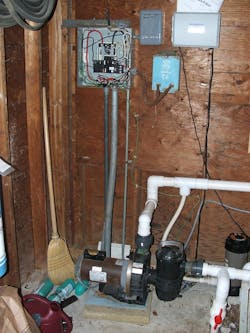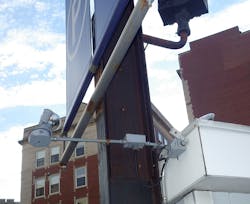All references are based on the 2017 edition of the NEC.
Poor Pool House Planning
I’m not sure this layout was a good idea. Leaving the panelboard uncovered is definitely a bad idea. The missing panelboard cover creates a shock hazard due to the energized parts being exposed instead of being guarded against accidental contact. Section 110.27(A) requires a completely secure enclosure.
Installing the pool motor and plumbing pipes in this spot has made an already crowded area a dangerous area as well. Where would an electrician stand while working in this panelboard? He or she would need to overextend their reach or stand uncomfortably and off-balance. Either way creates an extra level of danger for the electrician. The working space in front of this panelboard must be kept clear to the depth, width, and height dimensions required by Sec. 110.26(A).
The rusted flexible metal conduit (FMC) on the right side of the panelboard is a good indication that this area is probably being used to store pool chemicals and would now be considered a corrosive environment as specified in Sec. 680.14(A). Section 680.14(B) spells out which wiring methods are permitted in this type of location, and FMC is not one of those permitted methods.
Floodlight Installation Failure
The round weatherproof box installed at the end of this conduit is not properly supported. Using rigid metal conduit (RMC) to support a box is permitted under very specific conditions, but this installer did not follow those rules.
The general rule in Sec. 314.23(F) permits the use of two RMCs or intermediate metal conduits (IMCs) threaded wrenchtight into the enclosure to support a box not greater than 100 cu in. The conduits then need to be secured within 18 in. of the box. This box only has one conduit supporting it, in addition to having a compression fitting threaded into the box instead of having the conduit threaded directly into the box. Perhaps the installer was trying to take advantage of Exception No. 2 in Sec. 314.23(F) for this installation. That exception allows a single RMC to be used to support a box or conduit body if six conditions are met. This installation does not meet all those conditions. A focused read of Condition 6 for the exception reveals the problem again. The RMC must be threaded wrenchtight directly into the box without the use of a compression connector. On another topic, the use of flexible cord between the two boxes on the right could be considered a violation of Sec. 400.12(1).
About the Author

Russ LeBlanc
Owner
Russ started in the electrical trade as an apprentice in 1985. He worked his way up to become a Journeyman Electrician and then eventually became a Master Electrician and Licensed Construction Supervisor. In 1999 Russ become an Electrical Instructor for The Peterson School of Engineering in Massachusetts where he developed his passion for teaching, and quickly became Department Head of Electrical Instruction. Russ has taught thousands of apprentices, electricians, engineers, inspectors, and other electrical professionals during his career as an instructor. He continues to provide electrical professionals with Electrical Code seminars, Arc-Flash Awareness training seminars and educational material through his LeBlanc Consulting Services in North Reading, MA whose specialty is educating electricians. He has been an active member of the NFPA Electrical Section and has authored hundreds of National Electrical Code proposals and comments which have become Code rules to improve the safety for the electrical industry. Russ is also an IAEI certified Electrical Inspector.
Please visit www.russleblanc.net for more information.


